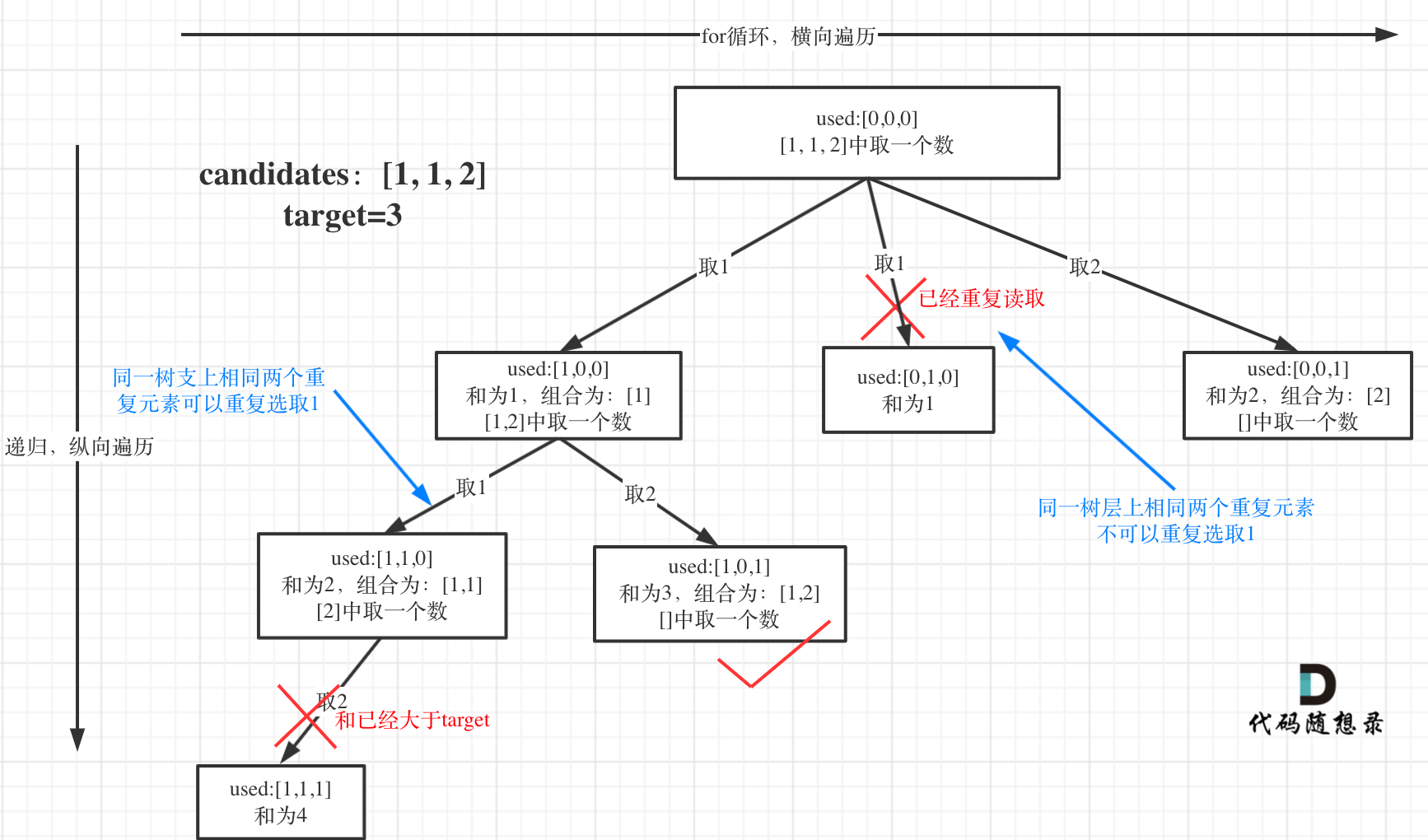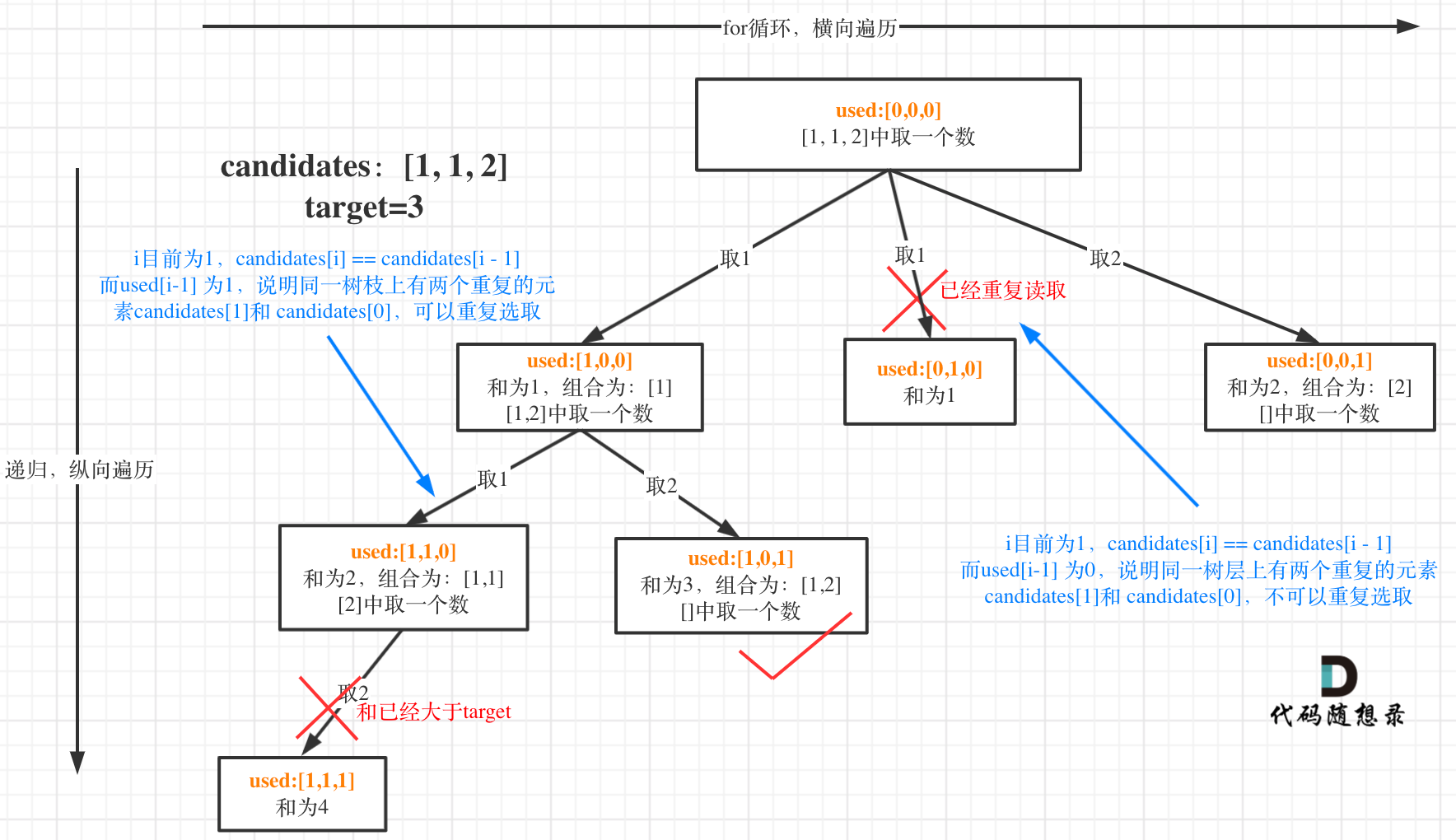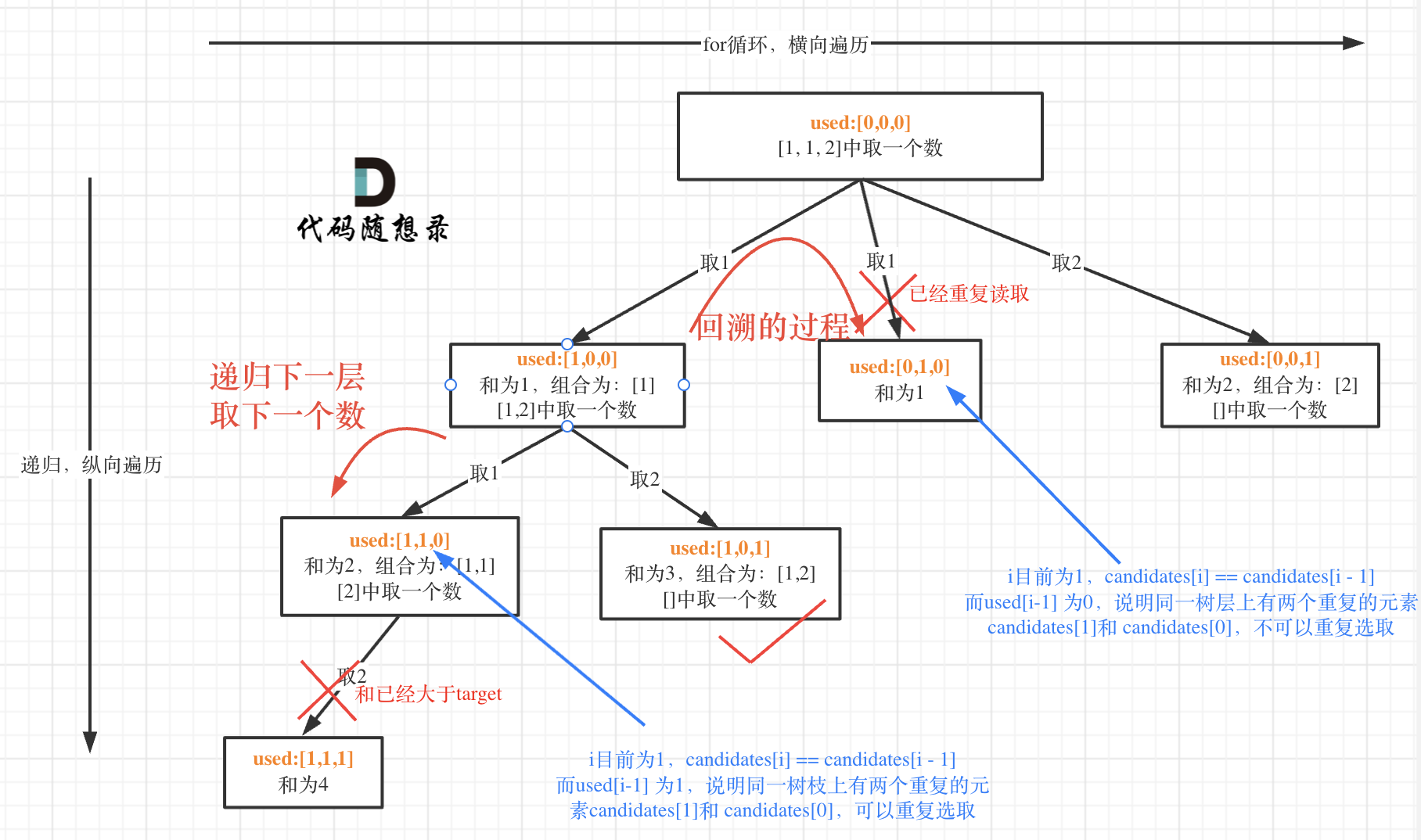参与本项目,贡献其他语言版本的代码,拥抱开源,让更多学习算法的小伙伴们受益!
这篇可以说是全网把组合问题如何去重,讲的最清晰的了!
40.组合总和II
给定一个数组 candidates 和一个目标数 target ,找出 candidates 中所有可以使数字和为 target 的组合。
candidates 中的每个数字在每个组合中只能使用一次。
说明: 所有数字(包括目标数)都是正整数。解集不能包含重复的组合。
- 示例 1:
- 输入: candidates = [10,1,2,7,6,1,5], target = 8,
- 所求解集为:
[
[1, 7],
[1, 2, 5],
[2, 6],
[1, 1, 6]
]
- 示例 2:
- 输入: candidates = [2,5,2,1,2], target = 5,
- 所求解集为:
[
[1,2,2],
[5]
]
算法公开课
《代码随想录》算法视频公开课:回溯算法中的去重,树层去重树枝去重,你弄清楚了没?| LeetCode:40.组合总和II,相信结合视频再看本篇题解,更有助于大家对本题的理解。
思路
这道题目和39.组合总和如下区别:
- 本题candidates 中的每个数字在每个组合中只能使用一次。
- 本题数组candidates的元素是有重复的,而39.组合总和是无重复元素的数组candidates
最后本题和39.组合总和要求一样,解集不能包含重复的组合。
本题的难点在于区别2中:集合(数组candidates)有重复元素,但还不能有重复的组合。
一些同学可能想了:我把所有组合求出来,再用set或者map去重,这么做很容易超时!
所以要在搜索的过程中就去掉重复组合。
很多同学在去重的问题上想不明白,其实很多题解也没有讲清楚,反正代码是能过的,感觉是那么回事,稀里糊涂的先把题目过了。
这个去重为什么很难理解呢,所谓去重,其实就是使用过的元素不能重复选取。 这么一说好像很简单!
都知道组合问题可以抽象为树形结构,那么“使用过”在这个树形结构上是有两个维度的,一个维度是同一树枝上使用过,一个维度是同一树层上使用过。没有理解这两个层面上的“使用过” 是造成大家没有彻底理解去重的根本原因。
那么问题来了,我们是要同一树层上使用过,还是同一树枝上使用过呢?
回看一下题目,元素在同一个组合内是可以重复的,怎么重复都没事,但两个组合不能相同。
所以我们要去重的是同一树层上的“使用过”,同一树枝上的都是一个组合里的元素,不用去重。
为了理解去重我们来举一个例子,candidates = [1, 1, 2], target = 3,(方便起见candidates已经排序了)
强调一下,树层去重的话,需要对数组排序!
选择过程树形结构如图所示:

可以看到图中,每个节点相对于 39.组合总和我多加了used数组,这个used数组下面会重点介绍。
回溯三部曲
- 递归函数参数
与39.组合总和套路相同,此题还需要加一个bool型数组used,用来记录同一树枝上的元素是否使用过。
这个集合去重的重任就是used来完成的。
代码如下:
vector<vector<int>> result; // 存放组合集合
vector<int> path; // 符合条件的组合
void backtracking(vector<int>& candidates, int target, int sum, int startIndex, vector<bool>& used) {- 递归终止条件
与39.组合总和相同,终止条件为 sum > target 和 sum == target。
代码如下:
if (sum > target) { // 这个条件其实可以省略
return;
}
if (sum == target) {
result.push_back(path);
return;
}sum > target 这个条件其实可以省略,因为在递归单层遍历的时候,会有剪枝的操作,下面会介绍到。
- 单层搜索的逻辑
这里与39.组合总和最大的不同就是要去重了。
前面我们提到:要去重的是“同一树层上的使用过”,如何判断同一树层上元素(相同的元素)是否使用过了呢。
如果candidates[i] == candidates[i - 1] 并且 used[i - 1] == false,就说明:前一个树枝,使用了candidates[i - 1],也就是说同一树层使用过candidates[i - 1]。
此时for循环里就应该做continue的操作。
这块比较抽象,如图:

我在图中将used的变化用橘黄色标注上,可以看出在candidates[i] == candidates[i - 1]相同的情况下:
- used[i - 1] == true,说明同一树枝candidates[i - 1]使用过
- used[i - 1] == false,说明同一树层candidates[i - 1]使用过
可能有的录友想,为什么 used[i - 1] false 就是同一树层呢,因为同一树层,used[i - 1] false 才能表示,当前取的 candidates[i] 是从 candidates[i - 1] 回溯而来的。
而 used[i - 1] == true,说明是进入下一层递归,去下一个数,所以是树枝上,如图所示:

这块去重的逻辑很抽象,网上搜的题解基本没有能讲清楚的,如果大家之前思考过这个问题或者刷过这道题目,看到这里一定会感觉通透了很多!
那么单层搜索的逻辑代码如下:
for (int i = startIndex; i < candidates.size() && sum + candidates[i] <= target; i++) {
// used[i - 1] == true,说明同一树枝candidates[i - 1]使用过
// used[i - 1] == false,说明同一树层candidates[i - 1]使用过
// 要对同一树层使用过的元素进行跳过
if (i > 0 && candidates[i] == candidates[i - 1] && used[i - 1] == false) {
continue;
}
sum += candidates[i];
path.push_back(candidates[i]);
used[i] = true;
backtracking(candidates, target, sum, i + 1, used); // 和39.组合总和的区别1:这里是i+1,每个数字在每个组合中只能使用一次
used[i] = false;
sum -= candidates[i];
path.pop_back();
}注意sum + candidates[i] <= target为剪枝操作,在39.组合总和有讲解过!
回溯三部曲分析完了,整体C++代码如下:
class Solution {
private:
vector<vector<int>> result;
vector<int> path;
void backtracking(vector<int>& candidates, int target, int sum, int startIndex, vector<bool>& used) {
if (sum == target) {
result.push_back(path);
return;
}
for (int i = startIndex; i < candidates.size() && sum + candidates[i] <= target; i++) {
// used[i - 1] == true,说明同一树枝candidates[i - 1]使用过
// used[i - 1] == false,说明同一树层candidates[i - 1]使用过
// 要对同一树层使用过的元素进行跳过
if (i > 0 && candidates[i] == candidates[i - 1] && used[i - 1] == false) {
continue;
}
sum += candidates[i];
path.push_back(candidates[i]);
used[i] = true;
backtracking(candidates, target, sum, i + 1, used); // 和39.组合总和的区别1,这里是i+1,每个数字在每个组合中只能使用一次
used[i] = false;
sum -= candidates[i];
path.pop_back();
}
}
public:
vector<vector<int>> combinationSum2(vector<int>& candidates, int target) {
vector<bool> used(candidates.size(), false);
path.clear();
result.clear();
// 首先把给candidates排序,让其相同的元素都挨在一起。
sort(candidates.begin(), candidates.end());
backtracking(candidates, target, 0, 0, used);
return result;
}
};
- 时间复杂度: O(n * 2^n)
- 空间复杂度: O(n)
补充
这里直接用startIndex来去重也是可以的, 就不用used数组了。
class Solution {
private:
vector<vector<int>> result;
vector<int> path;
void backtracking(vector<int>& candidates, int target, int sum, int startIndex) {
if (sum == target) {
result.push_back(path);
return;
}
for (int i = startIndex; i < candidates.size() && sum + candidates[i] <= target; i++) {
// 要对同一树层使用过的元素进行跳过
if (i > startIndex && candidates[i] == candidates[i - 1]) {
continue;
}
sum += candidates[i];
path.push_back(candidates[i]);
backtracking(candidates, target, sum, i + 1); // 和39.组合总和的区别1,这里是i+1,每个数字在每个组合中只能使用一次
sum -= candidates[i];
path.pop_back();
}
}
public:
vector<vector<int>> combinationSum2(vector<int>& candidates, int target) {
path.clear();
result.clear();
// 首先把给candidates排序,让其相同的元素都挨在一起。
sort(candidates.begin(), candidates.end());
backtracking(candidates, target, 0, 0);
return result;
}
};
总结
本题同样是求组合总和,但就是因为其数组candidates有重复元素,而要求不能有重复的组合,所以相对于39.组合总和难度提升了不少。
关键是去重的逻辑,代码很简单,网上一搜一大把,但几乎没有能把这块代码含义讲明白的,基本都是给出代码,然后说这就是去重了,究竟怎么个去重法也是模棱两可。
所以Carl有必要把去重的这块彻彻底底的给大家讲清楚,就连“树层去重”和“树枝去重”都是我自创的词汇,希望对大家理解有帮助!
其他语言版本
Java
使用标记数组
class Solution {
LinkedList<Integer> path = new LinkedList<>();
List<List<Integer>> ans = new ArrayList<>();
boolean[] used;
int sum = 0;
public List<List<Integer>> combinationSum2(int[] candidates, int target) {
used = new boolean[candidates.length];
// 加标志数组,用来辅助判断同层节点是否已经遍历
Arrays.fill(used, false);
// 为了将重复的数字都放到一起,所以先进行排序
Arrays.sort(candidates);
backTracking(candidates, target, 0);
return ans;
}
private void backTracking(int[] candidates, int target, int startIndex) {
if (sum == target) {
ans.add(new ArrayList(path));
}
for (int i = startIndex; i < candidates.length; i++) {
if (sum + candidates[i] > target) {
break;
}
// 出现重复节点,同层的第一个节点已经被访问过,所以直接跳过
if (i > 0 && candidates[i] == candidates[i - 1] && !used[i - 1]) {
continue;
}
used[i] = true;
sum += candidates[i];
path.add(candidates[i]);
// 每个节点仅能选择一次,所以从下一位开始
backTracking(candidates, target, i + 1);
used[i] = false;
sum -= candidates[i];
path.removeLast();
}
}
}
不使用标记数组
class Solution {
List<List<Integer>> res = new ArrayList<>();
LinkedList<Integer> path = new LinkedList<>();
int sum = 0;
public List<List<Integer>> combinationSum2( int[] candidates, int target ) {
//为了将重复的数字都放到一起,所以先进行排序
Arrays.sort( candidates );
backTracking( candidates, target, 0 );
return res;
}
private void backTracking( int[] candidates, int target, int start ) {
if ( sum == target ) {
res.add( new ArrayList<>( path ) );
return;
}
for ( int i = start; i < candidates.length && sum + candidates[i] <= target; i++ ) {
//正确剔除重复解的办法
//跳过同一树层使用过的元素
if ( i > start && candidates[i] == candidates[i - 1] ) {
continue;
}
sum += candidates[i];
path.add( candidates[i] );
// i+1 代表当前组内元素只选取一次
backTracking( candidates, target, i + 1 );
int temp = path.getLast();
sum -= temp;
path.removeLast();
}
}
}Python
回溯
class Solution:
def backtracking(self, candidates, target, total, startIndex, path, result):
if total == target:
result.append(path[:])
return
for i in range(startIndex, len(candidates)):
if i > startIndex and candidates[i] == candidates[i - 1]:
continue
if total + candidates[i] > target:
break
total += candidates[i]
path.append(candidates[i])
self.backtracking(candidates, target, total, i + 1, path, result)
total -= candidates[i]
path.pop()
def combinationSum2(self, candidates, target):
result = []
candidates.sort()
self.backtracking(candidates, target, 0, 0, [], result)
return result
回溯 使用used
class Solution:
def backtracking(self, candidates, target, total, startIndex, used, path, result):
if total == target:
result.append(path[:])
return
for i in range(startIndex, len(candidates)):
# 对于相同的数字,只选择第一个未被使用的数字,跳过其他相同数字
if i > startIndex and candidates[i] == candidates[i - 1] and not used[i - 1]:
continue
if total + candidates[i] > target:
break
total += candidates[i]
path.append(candidates[i])
used[i] = True
self.backtracking(candidates, target, total, i + 1, used, path, result)
used[i] = False
total -= candidates[i]
path.pop()
def combinationSum2(self, candidates, target):
used = [False] * len(candidates)
result = []
candidates.sort()
self.backtracking(candidates, target, 0, 0, used, [], result)
return result
回溯优化
class Solution:
def combinationSum2(self, candidates: List[int], target: int) -> List[List[int]]:
candidates.sort()
results = []
self.combinationSumHelper(candidates, target, 0, [], results)
return results
def combinationSumHelper(self, candidates, target, index, path, results):
if target == 0:
results.append(path[:])
return
for i in range(index, len(candidates)):
if i > index and candidates[i] == candidates[i - 1]:
continue
if candidates[i] > target:
break
path.append(candidates[i])
self.combinationSumHelper(candidates, target - candidates[i], i + 1, path, results)
path.pop()Go
主要在于如何在回溯中去重
使用used数组
var (
res [][]int
path []int
used []bool
)
func combinationSum2(candidates []int, target int) [][]int {
res, path = make([][]int, 0), make([]int, 0, len(candidates))
used = make([]bool, len(candidates))
sort.Ints(candidates) // 排序,为剪枝做准备
dfs(candidates, 0, target)
return res
}
func dfs(candidates []int, start int, target int) {
if target == 0 { // target 不断减小,如果为0说明达到了目标值
tmp := make([]int, len(path))
copy(tmp, path)
res = append(res, tmp)
return
}
for i := start; i < len(candidates); i++ {
if candidates[i] > target { // 剪枝,提前返回
break
}
// used[i - 1] == true,说明同一树枝candidates[i - 1]使用过
// used[i - 1] == false,说明同一树层candidates[i - 1]使用过
if i > 0 && candidates[i] == candidates[i-1] && used[i-1] == false {
continue
}
path = append(path, candidates[i])
used[i] = true
dfs(candidates, i+1, target - candidates[i])
used[i] = false
path = path[:len(path) - 1]
}
}不使用used数组
var (
res [][]int
path []int
)
func combinationSum2(candidates []int, target int) [][]int {
res, path = make([][]int, 0), make([]int, 0, len(candidates))
sort.Ints(candidates) // 排序,为剪枝做准备
dfs(candidates, 0, target)
return res
}
func dfs(candidates []int, start int, target int) {
if target == 0 { // target 不断减小,如果为0说明达到了目标值
tmp := make([]int, len(path))
copy(tmp, path)
res = append(res, tmp)
return
}
for i := start; i < len(candidates); i++ {
if candidates[i] > target { // 剪枝,提前返回
break
}
// i != start 限制了这不对深度遍历到达的此值去重
if i != start && candidates[i] == candidates[i-1] { // 去重
continue
}
path = append(path, candidates[i])
dfs(candidates, i+1, target - candidates[i])
path = path[:len(path) - 1]
}
}JavaScript
/**
* @param {number[]} candidates
* @param {number} target
* @return {number[][]}
*/
var combinationSum2 = function(candidates, target) {
const res = []; path = [], len = candidates.length;
candidates.sort((a,b)=>a-b);
backtracking(0, 0);
return res;
function backtracking(sum, i) {
if (sum === target) {
res.push(Array.from(path));
return;
}
for(let j = i; j < len; j++) {
const n = candidates[j];
if(j > i && candidates[j] === candidates[j-1]){
//若当前元素和前一个元素相等
//则本次循环结束,防止出现重复组合
continue;
}
//如果当前元素值大于目标值-总和的值
//由于数组已排序,那么该元素之后的元素必定不满足条件
//直接终止当前层的递归
if(n > target - sum) break;
path.push(n);
sum += n;
backtracking(sum, j + 1);
path.pop();
sum -= n;
}
}
};使用used去重
var combinationSum2 = function(candidates, target) {
let res = [];
let path = [];
let total = 0;
const len = candidates.length;
candidates.sort((a, b) => a - b);
let used = new Array(len).fill(false);
const backtracking = (startIndex) => {
if (total === target) {
res.push([...path]);
return;
}
for(let i = startIndex; i < len && total < target; i++) {
const cur = candidates[i];
if (cur > target - total || (i > 0 && cur === candidates[i - 1] && !used[i - 1])) continue;
path.push(cur);
total += cur;
used[i] = true;
backtracking(i + 1);
path.pop();
total -= cur;
used[i] = false;
}
}
backtracking(0);
return res;
};TypeScript
function combinationSum2(candidates: number[], target: number): number[][] {
candidates.sort((a, b) => a - b);
const resArr: number[][] = [];
function backTracking(
candidates: number[], target: number,
curSum: number, startIndex: number, route: number[]
) {
if (curSum > target) return;
if (curSum === target) {
resArr.push(route.slice());
return;
}
for (let i = startIndex, length = candidates.length; i < length; i++) {
if (i > startIndex && candidates[i] === candidates[i - 1]) {
continue;
}
let tempVal: number = candidates[i];
route.push(tempVal);
backTracking(candidates, target, curSum + tempVal, i + 1, route);
route.pop();
}
}
backTracking(candidates, target, 0, 0, []);
return resArr;
};Rust
impl Solution {
pub fn backtracking(result: &mut Vec<Vec<i32>>, path: &mut Vec<i32>, candidates: &Vec<i32>, target: i32, mut sum: i32, start_index: usize, used: &mut Vec<bool>) {
if sum == target {
result.push(path.to_vec());
return;
}
for i in start_index..candidates.len() {
if sum + candidates[i] <= target {
if i > 0 && candidates[i] == candidates[i - 1] && used[i - 1] == false { continue; }
sum += candidates[i];
path.push(candidates[i]);
used[i] = true;
Self::backtracking(result, path, candidates, target, sum, i + 1, used);
used[i] = false;
sum -= candidates[i];
path.pop();
}
}
}
pub fn combination_sum2(candidates: Vec<i32>, target: i32) -> Vec<Vec<i32>> {
let mut result: Vec<Vec<i32>> = Vec::new();
let mut path: Vec<i32> = Vec::new();
let mut used: Vec<bool> = vec![false; candidates.len()];
let mut candidates = candidates;
candidates.sort();
Self::backtracking(&mut result, &mut path, &candidates, target, 0, 0, &mut used);
result
}
}C
int* path;
int pathTop;
int** ans;
int ansTop;
//记录ans中每一个一维数组的大小
int* length;
int cmp(const void* a1, const void* a2) {
return *((int*)a1) - *((int*)a2);
}
void backTracking(int* candidates, int candidatesSize, int target, int sum, int startIndex) {
if(sum >= target) {
//若sum等于target,复制当前path进入
if(sum == target) {
int* tempPath = (int*)malloc(sizeof(int) * pathTop);
int j;
for(j = 0; j < pathTop; j++) {
tempPath[j] = path[j];
}
length[ansTop] = pathTop;
ans[ansTop++] = tempPath;
}
return ;
}
int i;
for(i = startIndex; i < candidatesSize; i++) {
//对同一层树中使用过的元素跳过
if(i > startIndex && candidates[i] == candidates[i-1])
continue;
path[pathTop++] = candidates[i];
sum += candidates[i];
backTracking(candidates, candidatesSize, target, sum, i + 1);
//回溯
sum -= candidates[i];
pathTop--;
}
}
int** combinationSum2(int* candidates, int candidatesSize, int target, int* returnSize, int** returnColumnSizes){
path = (int*)malloc(sizeof(int) * 50);
ans = (int**)malloc(sizeof(int*) * 100);
length = (int*)malloc(sizeof(int) * 100);
pathTop = ansTop = 0;
//快速排序candidates,让相同元素挨到一起
qsort(candidates, candidatesSize, sizeof(int), cmp);
backTracking(candidates, candidatesSize, target, 0, 0);
*returnSize = ansTop;
*returnColumnSizes = (int*)malloc(sizeof(int) * ansTop);
int i;
for(i = 0; i < ansTop; i++) {
(*returnColumnSizes)[i] = length[i];
}
return ans;
}Swift
func combinationSum2(_ candidates: [Int], _ target: Int) -> [[Int]] {
// 为了方便去重复,先对集合排序
let candidates = candidates.sorted()
var result = [[Int]]()
var path = [Int]()
func backtracking(sum: Int, startIndex: Int) {
// 终止条件
if sum == target {
result.append(path)
return
}
let end = candidates.count
guard startIndex < end else { return }
for i in startIndex ..< end {
if i > startIndex, candidates[i] == candidates[i - 1] { continue } // 去重复
let sum = sum + candidates[i] // 使用局部变量隐藏回溯
if sum > target { continue } // 剪枝
path.append(candidates[i]) // 处理
backtracking(sum: sum, startIndex: i + 1) // i+1避免重复访问
path.removeLast() // 回溯
}
}
backtracking(sum: 0, startIndex: 0)
return result
}Scala
object Solution {
import scala.collection.mutable
def combinationSum2(candidates: Array[Int], target: Int): List[List[Int]] = {
var res = mutable.ListBuffer[List[Int]]()
var path = mutable.ListBuffer[Int]()
var candidate = candidates.sorted
def backtracking(sum: Int, startIndex: Int): Unit = {
if (sum == target) {
res.append(path.toList)
return
}
for (i <- startIndex until candidate.size if sum + candidate(i) <= target) {
if (!(i > startIndex && candidate(i) == candidate(i - 1))) {
path.append(candidate(i))
backtracking(sum + candidate(i), i + 1)
path = path.take(path.size - 1)
}
}
}
backtracking(0, 0)
res.toList
}
}C#
public class Solution
{
public List<IList<int>> res = new List<IList<int>>();
public List<int> path = new List<int>();
public IList<IList<int>> CombinationSum2(int[] candidates, int target)
{
Array.Sort(candidates);
BackTracking(candidates, target, 0, 0);
return res;
}
public void BackTracking(int[] candidates, int target, int start, int sum)
{
if (sum > target) return;
if (sum == target)
{
res.Add(new List<int>(path));
return;
}
for (int i = start; i < candidates.Length && sum + candidates[i] <= target; i++)
{
if (i > start && candidates[i] == candidates[i - 1]) continue;
sum += candidates[i];
path.Add(candidates[i]);
BackTracking(candidates, target, i + 1, sum);
sum -= candidates[i];
path.RemoveAt(path.Count - 1);
}
}
}
